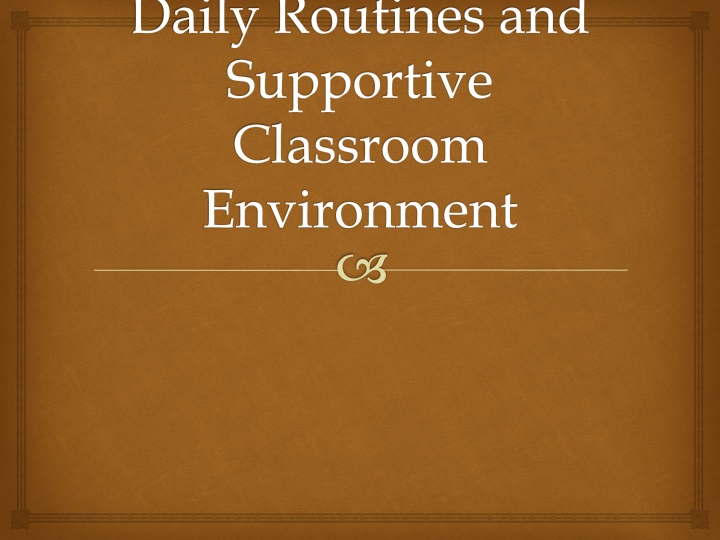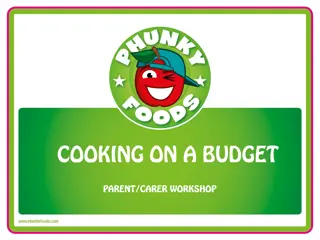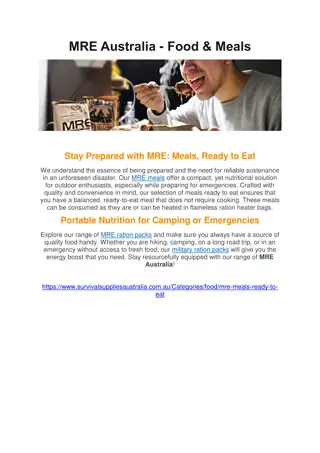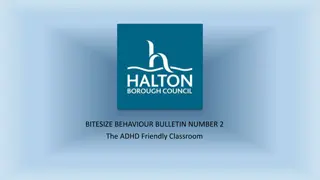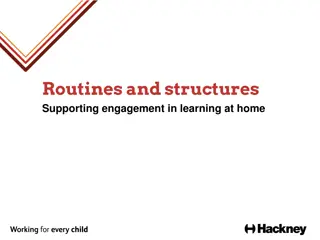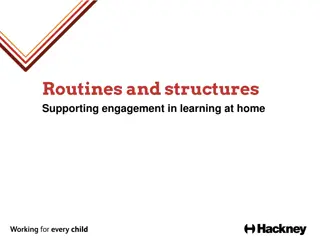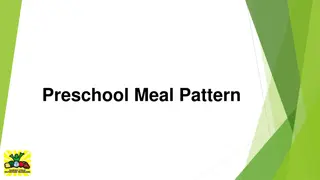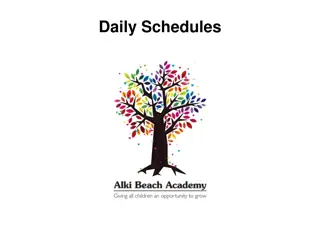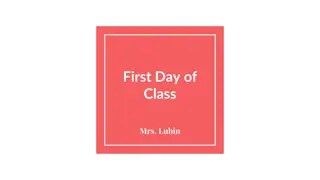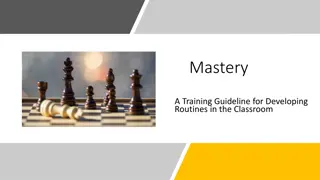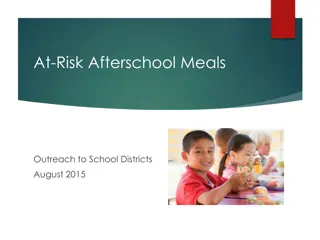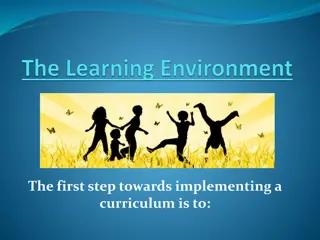Establishing Daily Routines and Nutritious Meals in a Supportive Classroom Environment
Daily routines are crucial in a classroom setting to provide structure and a sense of security for children. This involves activities like arrival, group time, outdoor play, choice time, and more. Additionally, planning appealing and nutritious meals with a focus on fruits, vegetables, and whole grains is essential for a child's development and well-being.
Download Presentation

Please find below an Image/Link to download the presentation.
The content on the website is provided AS IS for your information and personal use only. It may not be sold, licensed, or shared on other websites without obtaining consent from the author.If you encounter any issues during the download, it is possible that the publisher has removed the file from their server.
You are allowed to download the files provided on this website for personal or commercial use, subject to the condition that they are used lawfully. All files are the property of their respective owners.
The content on the website is provided AS IS for your information and personal use only. It may not be sold, licensed, or shared on other websites without obtaining consent from the author.
E N D
Presentation Transcript
Daily Routines and Supportive Classroom Environment
Daily Routines are the Backbone of the Program Establish daily routines/schedule so the children know what to expect, and they understand what is expected of them: Arrival greet families and children, help with separation Group time sing songs and fingerplays, sharing news, read books Breakfast sit with children, encourage conversation about food or topics of interest to children Choice time guide children in selecting interest areas. Sit with them, facilitate play to extend learning Outdoor play set up different areas, supervise and interact with children. Plan special activities
Daily Routines (cont.) Music Set up special activities: instruments, rhythm sticks, scarves, ribbons, bean bags Lunch family style Nap help children relax so they can fall asleep. Have soft music on. Supervise rest area. Provide quiet activities for the children who don t sleep Snack family style Departure Involve children in quiet activities. Greet parents and share something about the child s day
DAILY SCHEDULE Arrival: Children arrive, morning activities/choice time 7:30 8:15 8:20 8:30 Group time: (greeting, songs, story time) 8:30 9:00 Breakfast 9:00 10:10 Outdoor play: Children select from a variety of activities in interest areas 10:10-10:15 Large group: transition to indoor activities 10:15-10:30 Small Group: Table sensory activities or other planned activities according to children s interests or needs 10:30-11:20 11:20-11:30 Choice time: Children will choose from the activities in the interest areas Group time: Music, story time. Lunch set-up, put out cots 11:30 12:00 Lunch and Clean up 12:00 2:00 Nap/Rest Time: Quiet time, relaxation & sleeping 2:00 2:30 Snack 2:30 4:15 Outdoor /Indoor Play: pick up time for some children Small groups: afternoon planned activities based on Children s interests 4:15 4:30 Story Time and Dismissal
Planning Appealing and Nutritious Meals
Fruit: Let your preschooler enjoy a variety of whole or bite-sized fruits such as apples, sliced bananas, and mandarin orange pieces. Serve 100% fruit juice in small amounts and less often. Vegetables: Prepare red, orange, and dark-green vegetables like tomatoes, sweet potatoes, and broccoli as part of your child s meals and snacks. Grains: Make at least half their grains whole grains by offering 100% whole-grain cereals, breads, and pasta.
Protein Foods: Choose a variety of protein foods such as seafood, beans, and small portions of meat or poultry. Dairy: Give them low-fat milk, yogurt, and cheese to provide much needed calcium. Encourage water instead of fruit juice or sugary drinks Too much 100% juice or sugar-sweetened beverages, such as soda, juice drinks, or sport drinks, can add more calories than your child needs.
Check out the sodium (salt) in canned food, bread and frozen meals: Read the Nutrition Facts label to find foods with lower numbers. Watch the amount of saturated fats in foods: Cakes, cookies, ice cream, pizza, cheese, sausages, and hot dogs are okay sometimes but not every day.
Arranging a Supportive Educational Environment Organize the classroom into interest areas: Blocks: Creating an environment for block play: Location should be away from quiet areas and near other noisy activities such as dramatic play and have smooth, flat carpeting on the floor. Suggested materials are hardwood unit blocks, set of hollow blocks, people props (multi-ethnic family set, multi-ethnic community figures sets), animal props (farm, zoo, pets), road signs, small cars, trucks, trains, buses, boats.
Dramatic play: Creating an environment for dramatic play: location should be near the block area. Suggested materials dress-up clothes for men and women, pots, pans, dishes, utensils, plastic food, empty food containers/boxes relevant to different cultures, multicultural dolls, home-like touches such as curtains, a table cloth, pictures, plant, a small rug. Child-size furniture stove, refrigerator, table, chairs, sink, couch, doll bed, stroller, telephones, etc.
Manipulatives (toys and games): location should be near the quiet areas. Have open shelves so the children can make choices. Suggested materials puzzles, stacking cubes, interlocking toys, stringing beads, legos, dominoes, magnetic boards and felt boards with shapes, small props (animals, trucks, cars, boats, fruits,) for sorting, collection of plastic caps, keys, shells, etc.)
Art: location should be near a sink and on washable floors. Suggested materials assorted papers, colored pencils, markers, crayons, child-size scissors, assorted paint brushes and paint, collage materials, playdough, clay, washable ink stamp pads and assorted stamps, glue, glue sticks, tape.
Library: location should be away from the loud areas and have carpeted floor. Suggested materials variety of children s books (story books, nursery rhymes, alphabet and number books, multicultural books), tape or CD players, hand puppets, flannel boards, big pillows, blankets, stuffed animals.
Discovery/Science: Suggested materials table to hold displays and collections, animals and animal houses (cages, aquarium, ant farms), balance scales, magnifying glasses, eyedroppers, magnets and assorted objects, collection of natural materials (rocks, shells, pinecones, plants), books and displays.
Sand and water: location should be near a water source and on washable floors. Suggested materials buckets, measuring cups and spoons, scoops funnels, small containers, sponges, bottles, eyedroppers, whisks, tongs. Music and movement: location should be near loud areas. Suggested materials variety of musical instrument, including multicultural, bean bags, scarves, streamers, cassette or CD player.
Cooking: location should be near a water source and on washable floors. Suggested materials various bowls, measuring cups and spoons, whisk, potato masher, grater, rolling pins, knives, cutting boards, saucepans, recipe cards with pictures and words. Computers: location should be next or in the library area. Suggested materials one or more computers, printer, papers, software stored on the computer, educational games.
Outdoors: Should have spaces for sand and water play, wheeled toys, indoor materials that can be brought outdoors, playing games and pretend play, planting a garden, caring for living things, climbing and sliding apparatus. Materials for sand and water play buckets, shovels, spoons and scoops, funnels and sifters, pots and pans, muffin tins, old trucks and cars, plastic people and animals, etc. Materials for gross motor play various sizes balls, soccer net, basketball net, bowling pins and balls, baseball baths and ball, empty boxes, balance bin, various blocks https://www.youtube.com/watch?v=HQKD5evdcrg (Reggio Environment)
Create a classroom community Build relationship with each child get to know each child; talk to children respectfully; be sensitive to children s feelings, acknowledge children s accomplishments and progress Help children to make friends help them to cooperate, share, take turns, show empathy, and help others. Pair children to work on tasks, help them to negotiate and solve conflict
